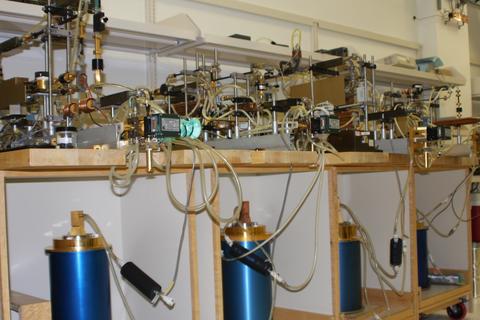Summary
The Spectrum Sensing and Noise project aims to advance fundamental metrology of microwave thermal noise together with applied metrology for spectrum sensing and assessment. Noise metrology has been an established research area of research at NBS and NIST in Boulder since the beginning at the Central Radio Propagation Laboratory.
Description

Reports in the NIST Technical Notes series were extensive measurements of radiated noise. Researchers also made key early contributions to standardizing guided-wave noise measurements in microwave systems. These contributions continue to underpin our ongoing work, but basic applications and hardware capabilities have outpaced progress in the noise metrology discipline, leaving significant opportunities for new research with substantial impact. Current capabilities include theory and practice of guided-wave, radiated, and cryogenic noise at various frequencies from 30 MHz to 110 GHz. To use this to support predictive capability in crowded spectrum problems, we have begun an extensive research effort to extend this metrology into the system's domain. This means relating physical conditions to other spectrum activity, impacts on users, and behavior in practical environments. These research efforts fall within the following CTL focus areas:
- Foundational Metrology for Communications – by modernizing fundamental noise metrology to provide unprecedented fine frequency resolution while maintaining the unbroken traceability chain for measurements of microwave noise parameters;
- Trusted Spectrum Testing – with noise calibrations and test methods applied to NASCTN projects, as well as other collaborators in industry, academia, and government;
- Next Generation Wireless and Beyond – by the advancement of metrology for sensitive wireless technology, applied practices for software-defined radios as serious spectrum metrology tools, and technology for the assessment of new frontiers in the air- and space-borne spectrum sharing
Major Accomplishments
- A digital radiometer instrument which improved spectral resolution and detection efficiency in noise measurements was developed.
- A spectrum monitoring network and coordinated its operation was designed during the COVID-19 pandemic.
- Introduced a new blackbody target to disseminate SI brightness-temperature traceability, which is crucial to space-based remote sensing.
- A theory of measurement uncertainties of noise-influenced scattering-parameter measurements was built.
- Improved alternatives for assessing spectrum sensor resiliency in the presence of powerful signals has been proposed.

